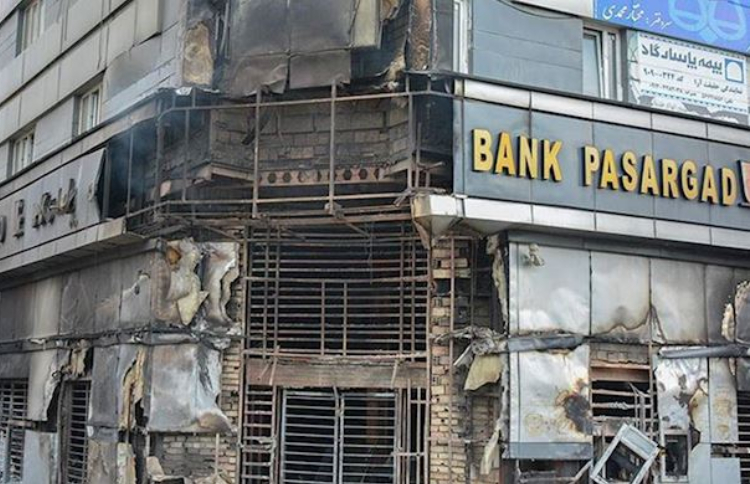
By Pooya Stone
During recent protests in Iran, protesters time and again targeted banks and financial institutes and set them ablaze. However, there is a question of why are the Iranian people torching these centers? And eventually, aren’t people supposed to answer their economic grievances through these financial systems?
In over a week, however, the Iranian demonstrators torched a significant number of banks, but the banks were not the only centers that came under the assault of the fed-up people. The reality is the Iranian authorities try to emphasize the torching of banks in their remarks and outlets to conceal the attacks against the bases of the Revolutionary Guards (IRGC) and security forces. Nonetheless, it is crucial to consider that youths torch banks due to their ties to government organs as opposed to the officials’ efforts to present them as private institutes.
Javan #Online: Iran “Rioters” #AIM to Attack “Sensitive Military and Law Enforcement Centers” https://t.co/2FwNLBAUyU via @iranfocus #Iranfreedom #freeiran #MEK #Iran @USAdarFarsi pic.twitter.com/eDa5P8uTOx
— Iran Focus (@Iran_Focus) November 23, 2019
According to Ruydad 24, a state-run news website, which quoted a banking official, “Since November 15, more than 1,000 banks’ branches have been destroyed. The statistics of part of this destruction were as follows:
– 120 branches of ‘Mellat’ bank
– 100 branches of ‘Maskan’ bank
– Twenty branches of ‘Passargad’ bank.”
According to this banking official’s remarks, the domestic property of each of these banks is estimated at 60 million tomans. “During the unrest, 46 ATMs were destroyed between 20% to 100% in Khoramabad alone. Also, 36 bank branches in Khorramabad county were damaged, and five branches were set on the fire that damaged between 20% to 100%,” Ruidad 24 website published in the same report.
In Iran, the banks are lining their pockets by getting mind-blowing interests from the deprived people. They seize the ordinary people’s properties by promising narrow benefits. But instead, Iranian banks invest the people’s wealth in profitable transactions in favor of their leading investors. Investors are generally government-linked institutions and personalities, as well as security and military organizations such as the Revolutionary Guards (IRGC).
#IRGC Imports’ Role in Bankrupting #Iran ‘s #Economy https://t.co/jyAaQKOFEu pic.twitter.com/cSJHZ6quYP
— Iran Focus (@Iran_Focus) October 31, 2017
Notably, the IRGC as a terrorist organization abuses Iran’s banking system and various industrial and commercial sectors in funding terrorism. In this regard, several Iranian banks, including the Central Bank of Iran, provide facilities for the IRGC. Over last week, protesters set some of these “banks” ablaze in different provinces.
“Unfortunately, some of our banks have their own firms. They take people’s savings and collect them in a savings store. Then they establish a company by themselves and become involved in construction and commercial activities. What are they doing? It is not acceptable!” Iran’s President Hassan Rouhani stated in a televised interview with Channel Tow on May 5, 2014.
While bank profits in the world are on average 2% to 3%, this figure is up to 30% in Iranian banks. “In our banking system, we have different interest rates from 14% to 26%. It is better to say that this rate is illegal in several financial institutions. Regrettably, we hear some news about the interest rate even higher than 30%,” former economy minister Ali Tayyeb Nia said in a televised interview with Channel Tow on October 21, 2014.
Regardless of state-owned banks, many “private banks” are generally dominated by security and military institutions, including:
– ‘Ansar’ Bank, owned by the Revolutionary Guards (IRGC)
– ‘Qavamin’ Bank, owned by the State Security Forces (Niruy-e Entezami)
– ‘Mehr’ Bank, owned by the paramilitary Basij force
– ‘Hekmat-e Iranian’ Bank, owned by the Islamic Republic Army
There are also several banks such as ‘Parsian,’ ‘Saman,’ ‘Passargad,’ ‘Dey,’ ‘Karafarin,‘ etc. which are controlled by Iranian officials or affiliated to government organs. Remarkably, the banks, as mentioned above, are the ones that have been robbing people’s property for years. And for months, the creditors have held sit-ins and rallies in front of these plundering centers.
#Corruption in #Iran: 110 Million Dirhams Have Been Lost in Parsian Bank https://t.co/HhGsKnwb8S via @iranfocus #Iranfreedom #freeiran #MEK #Iran @USAdarFarsi pic.twitter.com/r4BRp2JehE
— Iran Focus (@Iran_Focus) November 6, 2019
Factually, the banks pull money out of people’s pockets as deposits and invest in profitable business sectors such as tower construction, import projects, and brokerage through the private chain and satellite institutions and companies, rather than lending to factories and institutions. Eventually, profits of these investments turn back to the pockets of the banks’ shareholders, who are affiliated with the government.
Of course, the counter industrial role of banks is not covered up in Iran. Insofar as Hassan Rouhani underlined this truth in his televised interview with Channel One in 2018. He said, “The bank is an interesting thing. It gets money from people and collects them to launch a manufacturing business,” Channel One state-run TV broadcasted on June 19, 2017.
In conclusion, the Iranian government employs the banking system for improving its oppressive apparatus and exporting terrorism instead of serving the people. Contrary to normal states, authorities use the Iranian banks to fund terrorist proxies such as Lebanese Hezbollah, Shiite militias in Iraq, rebel Houthis in Yemen, etc. in the region at the expense of the Iranian people. Therefore, the protesters, who see no profit in these “financial institutions,” in parallel with chanting against the regime’s destructive policies, are setting these government-owned facilities on fire.


